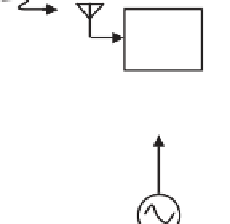Global Positioning System Reference
In-Depth Information
dicted code phase (computed using the 2-second error approximate time) to provide
a first estimate of the common-mode time error. This correction represents most of
the common-error time contribution to code phase in Figure 9.41; thus, the remain-
ing satellites can be searched for using constrained or limited code phase search
space, substantially reducing the size of the total Doppler/code phase uncertainty
search space.
Frequency.
Figure 9.41 shows that the frequency uncertainty dimension of the
satellite search process is dominated by the reference oscillator uncertainty. The
other contributions are small, with position uncertainties of tens of kilometers
assumed. If one assumes a 0.5- to 1.0-ppm reference oscillator is used for GPS, it is
by far the largest contributor to Doppler uncertainty and is common mode across all
satellites.
A cellular handset also contains a reference oscillator for its communication
function, and sharing or reusing the oscillator for GPS offers a compelling cost
advantage. Sharing the oscillator also enables substantial reduction in the reference
oscillator frequency uncertainty because all modern cellular telephones employ a
method of an AFC control loop to correct the oscillator frequency. This is based on a
frequency error relative to the cellular BS-to-handset signal, as shown in Figure 9.43.
The frequency of the cellular BS-to-handset signal is precisely controlled by the net-
work to better than 0.05 ppm within each network tower. As such, the handset AFC
control loop adjusts the frequency of the reference oscillator (via VCO in Figure
9.43) until the frequency difference is zero. Thus, the AFC function calibrates the
reference VCO oscillator to the same accuracy as the network-to-handset signal, or
0.05 ppm. Reusing this high-accuracy clock for GPS purposes enables significant
reduction in the number of Doppler uncertainty search bins, contributing to lower
overall TTFF and minimizing the number of required correlators needed to meet a
minimum performance criteria.
Some handsets physically adjust the frequency of the reference oscillator as
shown in Figure 9.43. Other handsets do not do so; instead, they let the oscillator
free-run and then adjust the control registers on a fractional-N synthesizer to pro-
Handset
GPS
Freq error
GPS
Rx
Phone
AFC
Phone
Rx
Calibrated cellular
network sigs (0.05 ppm)
Freq.
control
words
Synth
Synth
VCO
D/A
Figure 9.43
Typical handset AFC tuning of reference oscillator.
























Search WWH ::

Custom Search